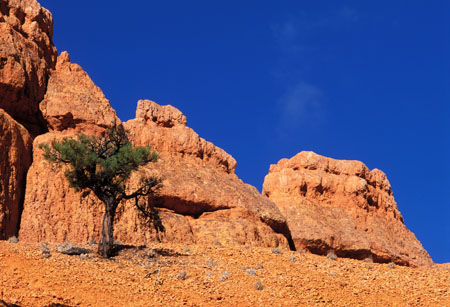The canyons of the world are incredibly varied, not only in size but also in their geology, colour and vegetation. They are deep valleys with steep sides cut by powerful rivers or flows of water into resistant rocks. They are mostly found in dry or cold areas where little soil forms and the valley sides consequently remain steep.
Classic examples of canyons are found in the southwest of the USA, the Drakensburg of South Africa, Australia’s Blue Mountains, and the Deccan Plateau in India. Lesser-known but equally photogenic examples can be found all over the world.
It is wise to heed local advice when entering a canyon. The larger ones are thousands of feet deep and hiking through them may prove exhausting. Temperatures vary enormously with depth and water may be difficult to find, so beware of dehydration. Smaller canyons are vulnerable to flash floods so an accurate weather forecast must be obtained before venturing inside.
 The orientation and other physical features of particular canyons determine the optimum times for photography, so visit at various times of the day to assess the changing situation. In many cases the best images are obtained by hiking down into the canyon and getting close to the most spectacular features. Colours change and shadows lengthen in the warmer light of early morning and late afternoon. Overhead midday light is likely to be harsh, flat and consequently less interesting.
The orientation and other physical features of particular canyons determine the optimum times for photography, so visit at various times of the day to assess the changing situation. In many cases the best images are obtained by hiking down into the canyon and getting close to the most spectacular features. Colours change and shadows lengthen in the warmer light of early morning and late afternoon. Overhead midday light is likely to be harsh, flat and consequently less interesting.
The precipitous angular features of canyons present endless photographic opportunities. There are always new viewpoints and camera angles to be found. However, good light is the key to the best images. Sunrise and sunset, and periods when the elevation of the sun is fairly low, are always worth investigating. Use a graduated neutral density filter to balance exposure of sky and land, and an 81A or 81B to add warmth if required. In general, use a tripod, a remote release, a slow shutter speed and a reasonably small aperture. When using a film or digital SLR it is also worth locking up the mirror and setting exposures manually. This reduces camera movement caused by releasing the shutter.
Smaller canyons, such as the slot canyons of the Utah, are arguably among the most photogenic. They are typically a couple of hundred feet deep and only a few feet wide – literally slots in the ground. Consequently, only an overhead sun can penetrate the depths of the canyon and illuminate the colourful striations and graceful curves of the walls. Photography is difficult in a human sense because the irregular shapes of the canyon walls and floor make access and the setting up of a tripod somewhat inconvenient. Good light is usually limited to a period of a couple of hours around midday, and only on sunny days. Overcast skies give diffused light, so colour is lost. Contrast between the canyon walls and the sky is large so exclude the latter from the image and base exposures on spot meter readings taken from highlight and shadow areas. In the days of film, Fuji Velvia ISO 50 was an excellent medium for this sort of work.






